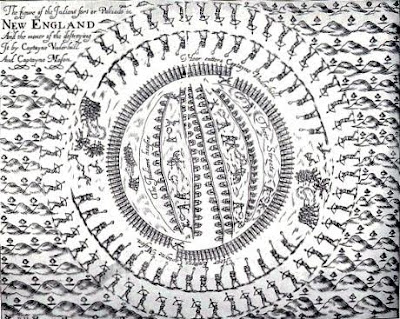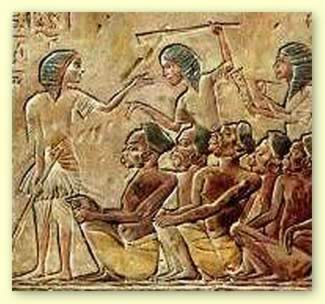My discovery that Thomas Baker’s church in Milford had a gallery for Indian slaves led me turn learn more...
The Milford church, called the meeting house, were my ancestor Thomas Baker worshiped had a “gallery” where slaves presumably stood during the service. Native Americans had been enslaved following the Pequot War in the 1630s. The gallery was probably for slaves of this origin. In Connecticut and throughout New England, where, 350 years later, descendants of Indians and Europeans still have an uneasy relationship, Indian slavery remains a rarely recited part of our history.

Out of a swampy thicket, near the blue waters of Long Island Sound, 200 old men, women and children stepped into the bright sunshine and entered a new world. Hundreds of edgy soldiers, mustered from villages and farms across Connecticut, had finally surrounded the Pequots and their leader, Sassacus. It was July 13, 1637, a critical day in the Pequot War that had consumed Puritan Connecticut for several years. Six weeks before, in a key victory for the colonists, Capt. John Mason had led a massacre at the Pequot fort in Mystic, killing as many as 700 Indians in a single hour.
http://usslave.blogspot.com/2011/02/chapter-two-first-slaves.html

A new chapter in American history was about to begin: Indian enslavement in Colonial America. Among the Pequots caught in the bog in what's now part of Fairfield, a group of perhaps 17, mostly children, were thought to have been exported as slaves. Others were handed out to soldiers as wartime booty. Historians believe these 17 Pequots later ended up on an island off Nicaragua. Like many of the Indian slaves sent from America over the next century, there is little record of what happened to them.

By the time the Treaty of Hartford was signed the following September, formally ending the war, the English had killed or enslaved more than 1,500 Pequot men, women and children, scholars believe.The colonists originally focused on the more warlike Pequots, but soon members of the Narragansetts, Nipmucks and Wampanoags were also enslaved. During the uneasy decades that followed, as the Puritans pushed deeper into Indian country and their numbers swelled, it was difficult to travel through Connecticut, Massachusetts or Rhode Island and not encounter an Indian slave. You would find Indian women working as domestic servants, taking care of children. You would find men working as farm laborers, drivers, working in a field, orchard or boatyard. You would find children taking care of livestockFor some Indians, servitude lasted only until age 24. But others were bound to masters for indefinite periods. Indian slaves and household servants appear on census rolls and court records well into the 18th century.
Indians came to public auction, "tied neck to neck," and sold for half of what an African might bring.. At times, there were so many captured Indians available that a few bushels of corn or 100 pounds of wool sufficed for payment.And on sailing ships, bound for the slave markets in Europe, Africa, the Caribbean and the Azores, Indians were packed away tightly by the profiteers, who kidnapped or bought them wholesale from Colonial authorities eager to finance an increasingly costly war against the Indians.
courant.com/news/special-reports/hc-indianslaves.artsep29,0,4052212.story
As in the rest of New England, there were few Black slaves until about 1700. Yet on the eve of the Revolution, Connecticut had the largest number of slaves (6,464) in New England, with one in four familes having one or two house slaves.
Although none of the extended family bearing the Lee surname have in their Inventories any indication of having owned slaves, they lived in a time in which slavery was legal, present in their communities and eventually prevalent. There is no record of the Conneticut Lee side of the family getting involved with abolition. A number of maternal branches off the paternal line had slave owning families. Some of those same maternal branches did have strong abolitionist involvement later on.
A primal fear of Indians, a desperate shortage of labor, a biblical sense of entitlement - these forces coalesced, leading to the enslavement of the Native Americans in southern New England in the 1600s. The colonists ultimately thought of the conflict as the "civilized" English against the "savage" natives.

Slavery was sanctioned and carefully regulated by many passages in the Hebrew Scriptures (Old Testament) largely in the Pentateuch - its first 5 books. Although slavery was widespread in Palestine during Jesus' ministry, he is not recorded as having expressed any opinion on it. Slavery was casually mentioned without criticism in the various books of the Christian Scriptures (New Testament). The authors appeared to accept slavery as a natural condition -- as a universal institution that was not particularly immoral.

The Christian church's main justification of the concept of slavery is based on Genesis 9:25-27. According to the Bible, the worldwide flood had concluded and there were only 8 humans alive on earth: Noah, his wife, their six sons and daughters in law. Noah's son Ham had seen "the nakedness of his father." So, Noah laid a curse -- not on Ham, who was guilty of some type of indiscretion. The sin was transferred to Noah's grandson Canaan. Such transference of sin from a guilty to an innocent person or persons is unusual in the world's religious and secular moral codes. It is normally considered highly unethical. However, it appears in many biblical passages. Christians traditionally believed that Canaan had settled in Africa. The dark skin of Africans became associated with this "curse of Ham." Thus slavery of Africans became religiously justifiable to them.
Fighting for abolition was a defining aspect of the Peter Van Arsdale’s life story which we will study in depth in a separate account. Peter’s influence has impacted the Lees ever since. His is son William Newland Lee fought bravely in the Civil War to end slavery, his grandson Theodore Lee was schooled in a Theology that grew out of the abolition movement, his 2x grandson Philip Lee had a career defined by his commitment to civil rights, and his 4x grand daughters Rachel and Sophie Lee were raised with a central moral focus on respect for diversity as a foundation for building a society that heals the wounds of historical racism and discrimination.
Further Reading
"Native People of Southern New England, 1500-1650," by Kathleen J. Bragdon. University of Oklahoma Press, 1996
"The Name of War," by Jill Lepore. Vintage, 1998
"The Pequots in Southern New England: The Fall and Rise of an American Indian Nation," edited by Laurence M. Hauptman, James D. Wherry. University of Oklahoma Press, 1990
"500 Nations: An Illustrated History of North American Indians," by Alvin M. Josephy Jr. Gramercy Books, 1994
"Indian Slavery in Colonial Times within the Present Limits of the United States," by Almon Wheeler Lauber. Columbia University Press, 1913
"Genocide and Enslavement of Native Peoples in Southern New England," paper by Kevin McBride, University of Connecticut
"The Changing Nature of Indian Slavery in New England, 1670-1720," paper by Margaret Ellen Newell, Ohio State University, Nov. 2001
Views: 1279
Comment
© 2024 Created by IIGSExecDirector.
Powered by
![]()

You need to be a member of Genealogy Wise to add comments!
Join Genealogy Wise